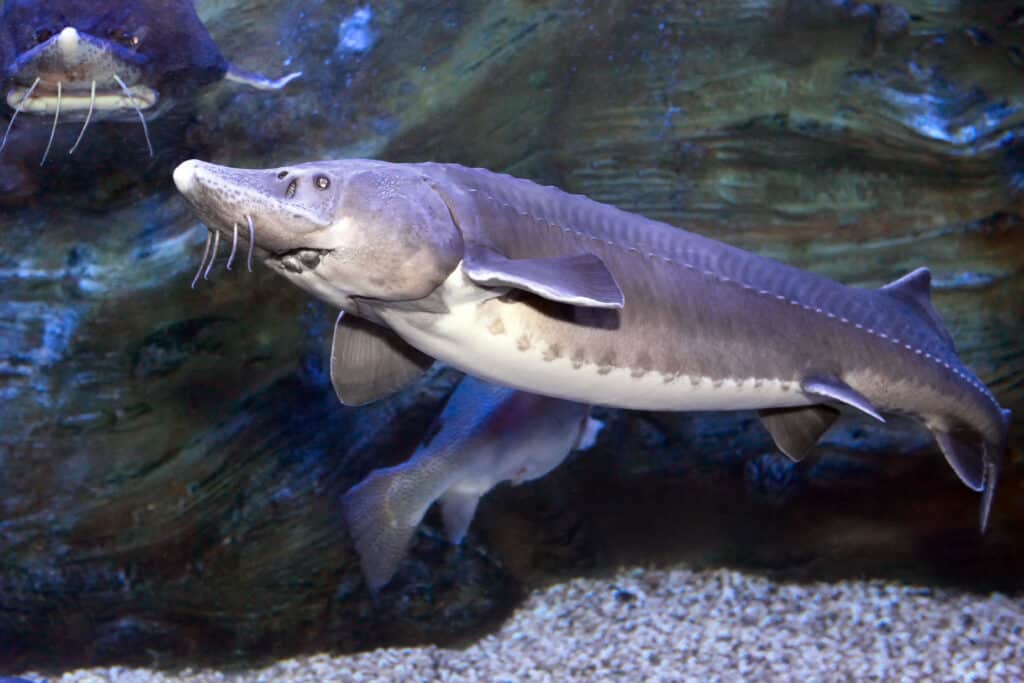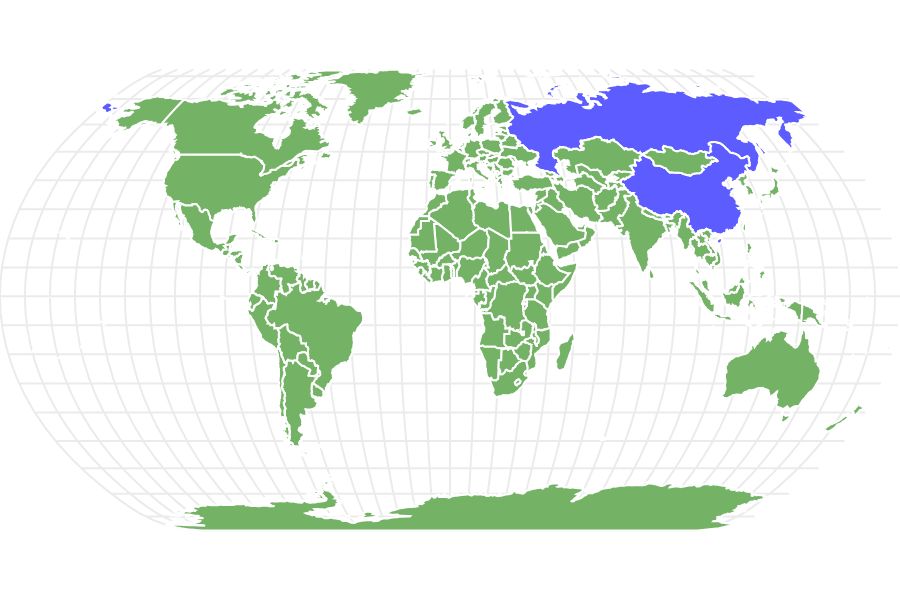Kaluga Sturgeon
Huso dauricus
One of the world's largest freshwater fish
Advertisement
Kaluga Sturgeon Scientific Classification
- Kingdom
- Animalia
- Phylum
- Chordata
- Class
- Actinopterygii
- Order
- Acipenseriformes
- Family
- Acipenseridae
- Genus
- Huso
- Scientific Name
- Huso dauricus
Read our Complete Guide to Classification of Animals.
Kaluga Sturgeon Conservation Status
Kaluga Sturgeon Facts
- Prey
- Zooplankton, insect, shrimp, fish
- Main Prey
- Salmon
- Name Of Young
- Larvae
- Group Behavior
- Solitary
- Fun Fact
- One of the world's largest freshwater fish
- Estimated Population Size
- 50 to 55 thousand
- Biggest Threat
- Poaching
- Most Distinctive Feature
- Barbells on the side of the mouth
- Distinctive Feature
- Produce extremely valuable caviar
- Temperament
- Somewhat aggressive
- Incubation Period
- 3 to 12 days
- Age Of Independence
- Upon hatching
- Average Spawn Size
- 4 million eggs
- Habitat
- Amur River Basin
- Predators
- Other sturgeons and large fish
- Diet
- Carnivore
- Lifestyle
- Solitary
- Favorite Food
- Salmon
- Number Of Species
- 1
- Location
- Russia and China
- Nesting Location
- Gravel beds
- Migratory
- 1
Kaluga Sturgeon Physical Characteristics
- Color
- Grey
- Yellow
- White
- Green
- Skin Type
- Scales
- Lifespan
- 55 years
- Weight
- Up to 2,205 pounds
- Length
- Up to 18.6 feet
- Age of Sexual Maturity
- 14 to 23 years
- Venomous
- No
- Aggression
- Medium
View all of the Kaluga Sturgeon images!
Summary
The Kaluga sturgeon is a large, carnivorous fish found throughout the Amur River basin in Russia and China. One of the most massive species in the sturgeon family, it is highly prized for its roe. As a result, they have been hunted almost to extinction and are listed as a Critically Endangered species by the IUCN.
5 Kaluga Sturgeon Facts
- Kaluga sturgeons reach sexual maturity between 10 and 14 years old, but the females only breed once every 4 years.
- While classified as freshwater fish, young Kaluga sturgeons inhabit saltwater regions from the northern Sea of Okhotsk to the waters around southern Japan.
- Poachers target these fish for their valuable roe, which has led to an 85% population decline in the past century.
- At their largest, Kaluga sturgeons can weigh up to 2,205 pounds and measure nearly 18.6 feet long.
- They are extraordinarily long-lived and can live up to 55 years in the wild.
Kaluga Sturgeon Classification and Scientific Name
The Kaluga sturgeon belongs to the sturgeon family Acipenseridae. Detailed classification of the Kaluga and other sturgeon remains challenging due to the highly individual variation between it and other sturgeon species. While many researchers believe they descended from a single ancestor, their exact phylogeny remains unclear. They belong to the genus Huso, which also contains the Beluga sturgeon. The word huso likely derives from the Old High German word hūso for sturgeon and other fish. Their full scientific name is Huso dauricus.
Kaluga Sturgeon Appearance

Generally speaking, most people don’t eat the meat of Kaluga sturgeon. Instead, they are highly prized for their roe or caviar.
©Tatiana Belova/Shutterstock.com
Also known as the “River Beluga,” the Kaluga sturgeon is one of the largest freshwater fish in the water. At their largest, they can measure up to 2,205 pounds and weigh up to 18.6 feet long. They have 5 rows of dermal scutes or bony plates along the length of the body. The lateral scutes tend The top of the back looks green-gray or black, while the bottom looks yellowish green. Like other sturgeon, they have long, flat, wide snouts and sport barbels on either side of the mouth.
Kaluga Sturgeon Distribution, Population, and Habitat
You can find Kaluga sturgeons throughout the Amur River Basin, which spans both China and Russia. Experts distinguish between several specific populations that tend to spend most of their lives in different parts of the river. These populations include one in the lower Amur, another in the middle Amur, another near the Zeya and Bureya Rivers, and a fourth near the estuary of the Sea of Okhotsk and the Sea of Japan. They are semi-anadromous, meaning that they spend part of their lives in freshwater and part of their lives in saltwater habitats. No matter where they spawn, most juvenile Kalugas migrate to and spend a few years in the Sea of Okhotsk or the Sea of Japan. Once they reach sexual maturity, they migrate back to their spawning ground to breed.
Kaluga Sturgeon Predators and Prey
As juveniles, Kalugas must contend with other aquatic predators, namely other larger sturgeons. That said, the primary threat to Kalugas comes not from other fish but from humans. Despite restrictions against poaching, hundreds or even thousands of them are illegally harvested annually for their eggs.
They are carnivorous predators that prey on a wide variety of animals. They are highly opportunistic and will eat almost anything that they can fit into their mouths. Young Kulagas primarily feed on zooplankton, insects, and shrimp. Once they get older, their diet shifts to other fish. Some of the species they prey on include salmon, pike, herring, carp, and other sturgeon.
Kaluga Sturgeon Reproduction and Lifespan
When it comes to spawning, scientists recognize two distinct groups of Kaluga sturgeon. One group spawns downstream near the lower part of the river basin, while another spawns near the middle part of the river. A single female can lay up to 41,400 eggs per 1 kilogram of body weight, or roughly 4 million eggs for an average female. That said, females only lay eggs approximately once every 3 to 5 years. They lay their eggs in shallow gravel beds, which gestate for anywhere from 4 to 12 days before hatching. Once they hatch, the larvae stay in their egg for up to 9 days feeding off the yolk. Kaluga sturgeons reach sexual maturity between 14 and 23 years of age and can live to be 55 years old.
Kaluga Sturgeon in Fishing and Cooking
Generally speaking, most people don’t eat the meat of Kaluga sturgeon. Instead, they are highly prized for their roe or caviar. A single female Kaluga can produce up to 44 pounds of Caviar, which can cost anywhere from $60 to $120 dollars per ounce. The caviar comes in a range of colors from gray to dark brown or olive green. Kaluga caviar has a firm texture and a buttery, earthy taste, making it highly desirable amongst connoisseurs. People frequently pair caviar with bread, small pancakes known as blini, or eggs, but you can also eat it on its own. Kaluga caviar should be kept refrigerated and is often served in a glass, bone, or tortoiseshell bowl to preserve its taste. Given its decline, the fishing and collection of Kaluga sturgeon roe is highly controlled, and poaching is illegal.
Kaluga Sturgeon Population
Starting in the late 19th century, fishing of these fish picked up in earnest. In 1881, fishers harvested nearly 595 tons of Kaluga sturgeon from the Amur River. By 1996, the annual catch fell to only 89 tons, a nearly 85% decline. Today, few adult sturgeon remain in the Amur River, as the vast majority pulled from the river are less than 10 years old. According to some estimates, only 50 or 55 thousand mature Kaluga sturgeons remain in the river. As a result, the IUCN lists the Kaluga sturgeon as a Critically Endangered species. Today, appendix II of the CITES agreement restricts the trade in Kaluga sturgeon. Although poaching them is illegal, hundreds or even thousands of fish are illicitly harvested every year, further contributing to their population decline.
Related Animals
View all 77 animals that start with KKaluga Sturgeon FAQs (Frequently Asked Questions)
Are Kaluge sturgeon carnivores, herbivores, or omnivores?
Kaluga sturgeon are carnivores that feed on a variety of aquatic animals. As juveniles they predominantly eat zooplankton, insects, and shrimp, while adults primarily eat salmon and other fish.
Where are Kaluga sturgeon found?
When they are young, some Kaluga sturgeons migrate to the brackish waters of the Sea of Okhotsk and the Sea of Japan. As adults they make their way back to the Amur River basin to mate and spend the rest of their lives.
How many Kaluga sturgeon are left?
The total adult population of mature Kaluga sturgeons likely measures between 50 and 55 thousand.
Is Kaluga caviar illegal?
Today, the trade and sale of Kaluga caviar is highly regulated. While you can buy sustainably harvested caviar from aquaculture farms, it is illegal to harvest wild Kaluga sturgeons for their meat or caviar.
Thank you for reading! Have some feedback for us? Contact the AZ Animals editorial team.
Sources
- Amur Information Center / Portal, Available here: http://amur-heilong.net/aic/en/1/03_species/0304Kaluga_sturgeon/
- Fishery Progress, Available here: https://fisheryprogress.org/sites/default/files/documents_actions/ENG_Okha%20FIP%20Action%207.%20Kaluga%20Info%20Sheet%20with%20Liabilities%20%28company%20internal%20policy%29%202019.pdf
- US Fish & Wildlife Service, Available here: https://ecos.fws.gov/ecp/species/9748
- NOAA Fisheries, Available here: https://www.fisheries.noaa.gov/species/kaluga-sturgeon

















